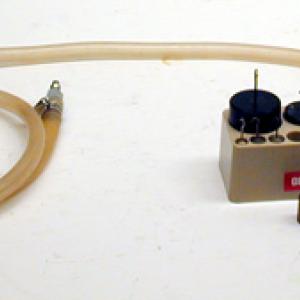College of Liberal Arts & Sciences
2C20.40 - Plates and Weights
Turn the air stream on full blast. Insert the lower plate with the small stem into the hole of the upper plate. When the plates get close enough together, the lower plate should be suction sealed against the top plate. At least 300 grams of weight can be applied to the lower plate before it falls off.
- Martin Gardner, "Three for Bernoulli", TPT, Vol. 34, # 2, Feb. 1996, p. 79.
- Chris Waltham, Sarah Bendall, Andrzei Kotlicki, "Bernoulli Levitation", AJP, Vol. 71, # 2, Feb. 2003, p. 176.
- Fj- 5: Freier and Anderson, A Demonstration Handbook for Physics.
- F- 215: "Spool and Card - Metal Disks", DICK and RAE Physics Demo Notebook.
- M- 295: Richard Manliffe Sutton, Demonstration Experiments in Physics.
- George M. Hopkins, "Gases", Experimental Science, p. 101.
- Martin Gardner, "Three for Bernoulli", Science Tricks, p. 19.
- Martin Gardner, "Bernoulli's Principle", Entertaining Science Experiments with Everyday Objects, p. 109.
- Vicki Cobb and Kathy Darling, "No Windfall Here", Bet You Can't!, p. 58.
- Janice VanCleave, "24, Super Breath", Teaching the Fun of Physics, p. 37.
- Brown, 333 Science Tricks & Experiments.
- "Bernoulli Levitator", Exploratorium Science Snackbook, p. 6.1 - 6.2.
- 3.03: R. D. Edge, "Bernoulli Effect", String and Sticky Tape Experiments.
- Bernoulli's Equation, Princeton University, https://www.princeton.edu/~asmits/Bicycle_web/Bernoulli.html
Disclaimer: These demonstrations are provided only for illustrative use by persons affiliated with The University of Iowa and only under the direction of a trained instructor or physicist. The University of Iowa is not responsible for demonstrations performed by those using their own equipment or who choose to use this reference material for their own purpose. The demonstrations included here are within the public domain and can be found in materials contained in libraries, bookstores, and through electronic sources. Performing all or any portion of any of these demonstrations, with or without revisions not depicted here entails inherent risks. These risks include, without limitation, bodily injury (and possibly death), including risks to health that may be temporary or permanent and that may exacerbate a pre-existing medical condition; and property loss or damage. Anyone performing any part of these demonstrations, even with revisions, knowingly and voluntarily assumes all risks associated with them.
